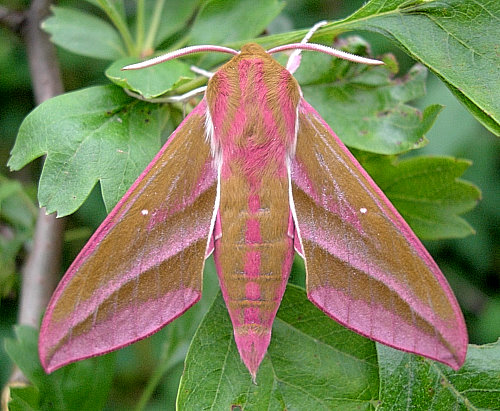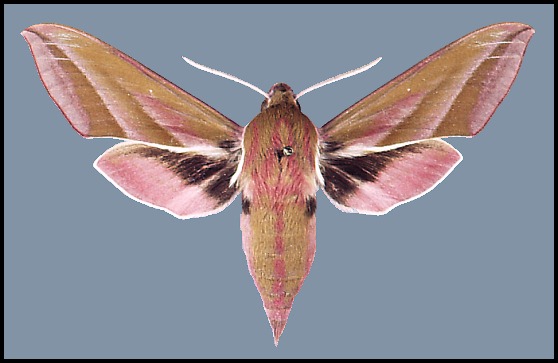Deilephila elpenor
Middle Hawk-moth ( Deilephila elpenor )
The Middle Hawk-moth ( Deilephila elpenor ) is a butterfly (moth ) from the family of moth ( Sphingidae ).
- 3.1 Flight times and caterpillars
- 3.2 food of the caterpillars
- 5.1 Notes and references
- 5.2 Literature
Features
The moths reach a wingspan of 45 to 60 millimeters. They have olive-green forewings, in which the wing leading edge is colored thin pink and on which three pink to pale violet, slightly oblique napkins are recognizable. The first is approximately only half of the blade. At it borders on a very small, punctate, white Diskoidalfleck. The second, near the wing outer edge and the third directly on this boundary both terminate in the wing tip. The hind wings are pink and have a black band at the base ( Basalbinde ). The body is olive-green and pink, with along the center of the abdomen also runs a pink colored longitudinal line and the hairy chest is alternately vertical stripes in the two colors. The antennae, legs and partially inside edge of the front wings are colored white.
The caterpillars are about 80 mm long. In younger stages the caterpillars are green, in the later stages they change their color to brown until shortly before pupation are brown black. The small, rather unassuming head is moved in danger in the chestpiece. The thick chest piece has on each side two notable features of eye-spots ( on the second and third segment), which make the animal appear threatening. These are brightly colored in contrast to the very similar caterpillars of the small wine enthusiast on one side and black on the other. Also sitting on the abdomen end Analhorn is longer and pointed, hump -like instead of just indicated.
- Caterpillar of the Middle wine enthusiast
Caterpillar on a fuchsia plant
Head and chest of the caterpillar
Similar Species
- Small Elephant Hawk-moth ( Deilephila porcellus )
Synonyms
- Sphinx elpenor Linnaeus, 1758 Syst. Nat. ( Edn 10 ) 1: 491
- Chcerocampa lewisii Butler, 1875 Proc. zool Soc. Lond. 1875: 247
- Sphinx porcus Retzius, 1783 Genera et Species Insect. : 34
- Pergesa szechuana Chu & Wang 1980
Occurrence
The animals arrive in Europe with the exception of the far north and in Asia, east to Japan before. In Central Europe it is the most common type of enthusiast. They live in moist areas, such as in riparian forests, or waters, but also in parks and gardens.
Way of life
The nocturnal moths fly to the nectar of flowers eyes.
Flight times and caterpillars
The moths fly in one generation from mid- May to July, the caterpillars are found from mid-June to August. In hot years or in the south a partial second generation may occur in August and September.
Food of the caterpillars
The caterpillars feed on mainly of willow herb such as Schmalblättrigem fireweed (Epilobium angustifolium), besides also at various Spring herbs, now and again to Fuchsia ( Fuchsia), the ordinary purple loosestrife ( Lythrum salicaria ) and Common Evening Primrose (Oenothera biennis ).
Development
The females lay their pale eggs singly or in small groups on the underside of the leaves of forage plants. On the day hiding from the hatching caterpillars and eat only at night. But adults caterpillars also eat a day. They pupate in the soil in a loose weave between plant parts. The dolls are unlike other dolls enthusiast heavily grained and also perforated between the segments. The moths emerge after hibernation.









